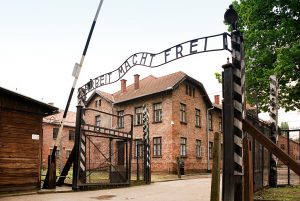
New Delhi. 27 January 2020. Many chapters of history are embedded in darkness and sorrow . However one might want these can never be undone. And one such chapter is the extermination of jews by Hitler during the second world war. One of the most saddening and unforgettable is the story of Auschwitz Concentration Camp in Poland and the world today is remembering the day it got liberated by the erstwhile Soviet Union 75 years ago on 27 January 1945.
The Auschwitz concentration camp was a complex of over 40 concentration and extermination camps operated by Nazi Germany in occupied Poland during World War II and the Holocaust. It consisted of Auschwitz I, the main camp (Stammlager) in Oświęcim; Auschwitz II–Birkenau, a concentration and extermination camp built with several gas chambers; Auschwitz III–Monowitz, a labor camp created to staff a factory for the chemical conglomerate IG Farben; and dozens of subcamps. The camps became a major site of the Nazis’ Final Solution to the Jewish Question.
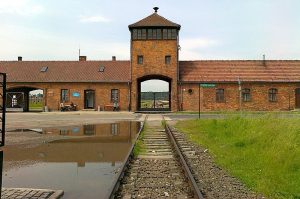
After Germany invaded Poland in September 1939, sparking World War II, the Schutzstaffel (SS) converted Auschwitz I, an army barracks, into a prisoner-of-war camp for Polish political prisoners. The first inmates, German criminals brought to the camp in May 1940 as functionaries, established the camp’s reputation for sadism. Prisoners were beaten, tortured, and executed for the most trivial reasons. The first gassings—of Soviet and Polish prisoners—took place in block 11 of Auschwitz I around August 1941. Construction of Auschwitz II began the following month, and from 1942 until late 1944 freight trains delivered Jews from all over German-occupied Europe to its gas chambers. Of the 1.3 million people sent to Auschwitz, 1.1 million died. The death toll includes 960,000 Jews (865,000 of whom were gassed on arrival), 74,000 non-Jewish Poles, 21,000 Roma, 15,000 Soviet prisoners of war, and up to 15,000 other Europeans. Those not gassed died of starvation, exhaustion, disease, individual executions, or beatings. Others were killed during medical experiments.
At least 802 prisoners tried to escape, 144 successfully, and on 7 October 1944 two Sonderkommando units, consisting of prisoners who staffed the gas chambers, launched an unsuccessful uprising. Only 789 staff (no more than 15 percent) ever stood trial;[several, including camp commandant Rudolf Höss, were executed. The Allies’ failure to act on early reports of atrocities in the camp by bombing it or its railways remains controversial.
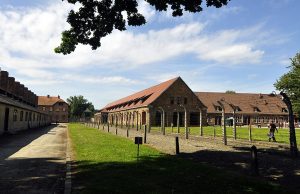
As the Soviet Red Army approached Auschwitz in January 1945, toward the end of the war, the SS sent most of the camp’s population west on a death march to camps inside Germany and Austria. Soviet troops entered the camp on 27 January 1945, a day commemorated since 2005 as International Holocaust Remembrance Day. In 1947 Poland founded the Auschwitz-Birkenau State Museum on the site of Auschwitz I and II, and in 1979 it was named a World Heritage Site by UNESCO.
The first gassings at Auschwitz took place in early September 1941, when around 850 inmates—Soviet prisoners of war and sick Polish inmates—were killed with Zyklon B in the basement of block 11 in Auschwitz I. The building proved unsuitable, so gassings were conducted instead in crematorium I, also in Auschwitz I, which operated until December 1942. There, more than 700 victims could be killed at once. Tens of thousands were killed in crematorium I. To keep the victims calm, they were told they were to undergo disinfection and de-lousing; they were ordered to undress outside, then were locked in the building and gassed. After its decommissioning as a gas chamber, the building was converted to a storage facility and later served as an SS air raid shelter. The gas chamber and crematorium were reconstructed after the war. Dwork and van Pelt write that a chimney was recreated; four openings in the roof were installed to show where the Zyklon B had entered; and two of the three furnaces were rebuilt with the original components.[
In early 1942, mass exterminations were moved to two provisional gas chambers (the “red house” and “white house”, known as bunkers 1 and 2) in Auschwitz II, while the larger crematoria (II, III, IV, and V) were under construction. Bunker 2 was temporarily reactivated from May to November 1944, when large numbers of Hungarian Jews were gassed. In summer 1944 the combined capacity of the crematoria and outdoor incineration pits was 20,000 bodies per day.[ A planned sixth facility—crematorium VI—was never built.
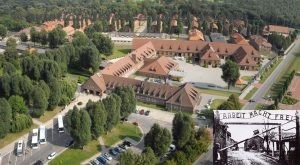
From 1942 Jews were being transported to Auschwitz from all over German-occupied Europe by rail, arriving in daily convoys. The gas chambers worked to their fullest capacity from May to July 1944, during the Holocaust in Hungary. A rail spur leading to crematoria II and III in Auschwitz II was completed that May, and a new ramp was built between sectors BI and BII to deliver the victims closer to the gas chambers (images top right). On 29 April the first 1,800 Jews from Hungary arrived at the camp. From 14 May until early July 1944, 437,000 Hungarian Jews, half the pre-war population, were deported to Auschwitz, at a rate of 12,000 a day for a considerable part of that period. The crematoria had to be overhauled. Crematoria II and III were given new elevators leading from the stoves to the gas chambers, new grates were fitted, and several of the dressing rooms and gas chambers were painted. Cremation pits were dug behind crematorium V. The incoming volume was so great that the Sonderkommando resorted to burning corpses in open-air pits as well as in the crematoria.
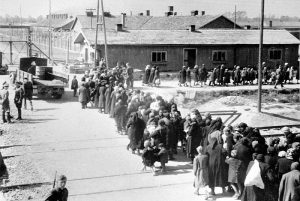
At least 1.3 million people were sent to Auschwitz between 1940 and 1945, and at least 1.1 million died. Overall 400,207 prisoners were registered in the camp: 268,657 male and 131,560 female. Raul Hilberg’s 1961 work, The Destruction of the European Jews, estimated that up to one million Jews had died in Auschwitz. In 1983 French scholar George Wellers was one of the first to use German data on deportations to calculate the death toll; he arrived at a figure of 1,471,595 deaths, including 1.35 million Jews and 86,675 non-Jewish Poles. A larger study in the late 1980s by Polish historian Franciszek Piper, published by Yad Vashem in 1991, used timetables of train arrivals combined with deportation records to calculate that, of the 1.3 million sent to the camp, 1,082,000 had died there between 1940 and 1945, a figure (rounded up to 1.1 million) that Piper regarded as a minimum. That figure came to be widely accepted.[
The Germans tried to conceal how many they had killed. In July 1942, according to Rudolf Höss’s post-war memoir, Höss received an order from Heinrich Himmler, via Adolf Eichmann’s office and SS commander Paul Blobel, that ” all mass graves were to be opened and the corpses burned. In addition the ashes were to be disposed of in such a way that it would be impossible at some future time to calculate the number of corpses burned.”
All pictures courtesy Wikipedia


























































































































